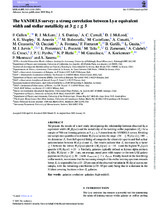| dc.contributor.author | Jarvis, M. J. | |
| dc.contributor.author | Cullen, F. | |
| dc.contributor.author | McLure, R. J. | |
| dc.date.accessioned | 2021-02-08T12:03:12Z | |
| dc.date.available | 2021-02-08T12:03:12Z | |
| dc.date.issued | 2020 | |
| dc.identifier.citation | Jarvis, M. J. et al. (2020). The VANDELS survey: a strong correlation between Ly α equivalent width and stellar metallicity at 3 ≤ z ≤ 5. Monthly Notices of the Royal Astronomical Society, 495(1), 1501–1510 | en_US |
| dc.identifier.issn | 1365-2966 | |
| dc.identifier.uri | https://doi.org/10.1093/mnras/staa1260 | |
| dc.identifier.uri | http://hdl.handle.net/10566/5860 | |
| dc.description.abstract | We present the results of a new study investigating the relationship between observed Ly α equivalent width (Wλ(Ly α)) and the metallicity of the ionizing stellar population ( Z⋆) for a sample of 768 star-forming galaxies at 3 ≤ z ≤ 5 drawn from the VANDELS survey. Dividing our sample into quartiles of rest-frame Wλ(Ly α) across the range −58A˚≲Wλ(Ly α) ≲110A˚, we determine Z⋆ from full spectral fitting of composite far-ultraviolet spectra and find a clear anticorrelation between Wλ(Ly α) and Z⋆. Our results indicate that Z⋆ decreases by a factor ≳ 3 between the lowest Wλ(Ly α) quartile (⟨Wλ(Ly α)⟩=−18A˚) and the highest Wλ(Ly α) quartile (⟨Wλ(Ly α)⟩=24A˚). Similarly, galaxies typically defined as Lyman alpha emitters (LAEs; Wλ(Ly α) >20A˚) are, on average, metal poor with respect to the non-LAE galaxy population (Wλ(Ly α) ≤20A˚) with Z⋆non-LAE ≳ 2 × Z⋆LAE. | en_US |
| dc.language.iso | en | en_US |
| dc.publisher | Oxford University Press | en_US |
| dc.subject | Galaxies: evolution | en_US |
| dc.subject | Galaxies: high-redshift | en_US |
| dc.subject | VANDELS survey | en_US |
| dc.subject | Ly α equivalent width | en_US |
| dc.subject | Metallicity of the ionizing stellar population | en_US |
| dc.title | The VANDELS survey: a strong correlation between Ly α equivalent width and stellar metallicity at 3 ≤ z ≤ 5 | en_US |
| dc.type | Article | en_US |

